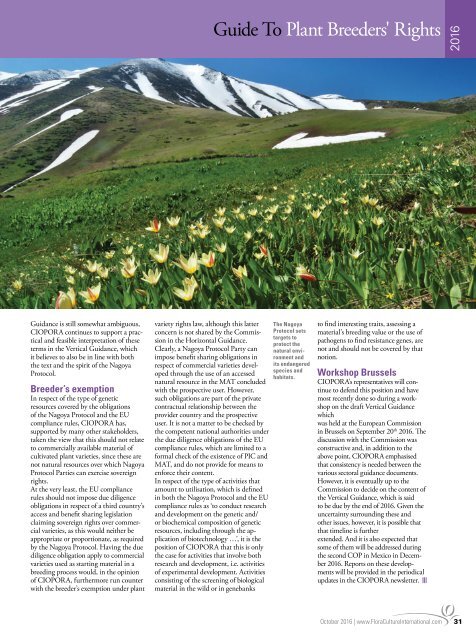2016 CIOPORA Guide to Plant Breeders' Rights
CIOPORA annual magazine on Intellectual Property protection for plant innovations. Produced in cooperation with FloraCulture International. Read in the 2016 issue: - CIOPORA completes positions on Plant Breeders´ Rights - Does the U.S. miss out on additional new varieties developed abroad? - Update on the Nagoya Protocol and its EU implementation - Intellectual Property Systems: a tool, not a goal - European Trademarks and Variety : The chaos has arrived.
CIOPORA annual magazine on Intellectual Property protection for plant innovations. Produced in cooperation with FloraCulture International.
Read in the 2016 issue:
- CIOPORA completes positions on Plant Breeders´ Rights
- Does the U.S. miss out on additional new varieties developed abroad?
- Update on the Nagoya Protocol and its EU implementation
- Intellectual Property Systems: a tool, not a goal
- European Trademarks and Variety : The chaos has arrived.
Create successful ePaper yourself
Turn your PDF publications into a flip-book with our unique Google optimized e-Paper software.
<strong>Guide</strong> To <strong>Plant</strong> <strong>Breeders'</strong> <strong>Rights</strong><br />
<strong>2016</strong><br />
Guidance is still somewhat ambiguous,<br />
<strong>CIOPORA</strong> continues <strong>to</strong> support a practical<br />
and feasible interpretation of these<br />
terms in the Vertical Guidance, which<br />
it believes <strong>to</strong> also be in line with both<br />
the text and the spirit of the Nagoya<br />
Pro<strong>to</strong>col.<br />
Breeder’s exemption<br />
In respect of the type of genetic<br />
resources covered by the obligations<br />
of the Nagoya Pro<strong>to</strong>col and the EU<br />
compliance rules, <strong>CIOPORA</strong> has,<br />
supported by many other stakeholders,<br />
taken the view that this should not relate<br />
<strong>to</strong> commercially available material of<br />
cultivated plant varieties, since these are<br />
not natural resources over which Nagoya<br />
Pro<strong>to</strong>col Parties can exercise sovereign<br />
rights.<br />
At the very least, the EU compliance<br />
rules should not impose due diligence<br />
obligations in respect of a third country’s<br />
access and benefit sharing legislation<br />
claiming sovereign rights over commercial<br />
varieties, as this would neither be<br />
appropriate or proportionate, as required<br />
by the Nagoya Pro<strong>to</strong>col. Having the due<br />
diligence obligation apply <strong>to</strong> commercial<br />
varieties used as starting material in a<br />
breeding process would, in the opinion<br />
of <strong>CIOPORA</strong>, furthermore run counter<br />
with the breeder’s exemption under plant<br />
variety rights law, although this latter<br />
concern is not shared by the Commission<br />
in the Horizontal Guidance.<br />
Clearly, a Nagoya Pro<strong>to</strong>col Party can<br />
impose benefit sharing obligations in<br />
respect of commercial varieties developed<br />
through the use of an accessed<br />
natural resource in the MAT concluded<br />
with the prospective user. However,<br />
such obligations are part of the private<br />
contractual relationship between the<br />
provider country and the prospective<br />
user. It is not a matter <strong>to</strong> be checked by<br />
the competent national authorities under<br />
the due diligence obligations of the EU<br />
compliance rules, which are limited <strong>to</strong> a<br />
formal check of the existence of PIC and<br />
MAT, and do not provide for means <strong>to</strong><br />
enforce their content.<br />
In respect of the type of activities that<br />
amount <strong>to</strong> utilisation, which is defined<br />
in both the Nagoya Pro<strong>to</strong>col and the EU<br />
compliance rules as ‘<strong>to</strong> conduct research<br />
and development on the genetic and/<br />
or biochemical composition of genetic<br />
resources, including through the application<br />
of biotechnology …’, it is the<br />
position of <strong>CIOPORA</strong> that this is only<br />
the case for activities that involve both<br />
research and development, i.e. activities<br />
of experimental development. Activities<br />
consisting of the screening of biological<br />
material in the wild or in genebanks<br />
The Nagoya<br />
Pro<strong>to</strong>col sets<br />
targets <strong>to</strong><br />
protect the<br />
natural environment<br />
and<br />
its endangered<br />
species and<br />
habitats.<br />
<strong>to</strong> find interesting traits, assessing a<br />
material’s breeding value or the use of<br />
pathogens <strong>to</strong> find resistance genes, are<br />
not and should not be covered by that<br />
notion.<br />
Workshop Brussels<br />
<strong>CIOPORA</strong>'s representatives will continue<br />
<strong>to</strong> defend this position and have<br />
most recently done so during a workshop<br />
on the draft Vertical Guidance<br />
which<br />
was held at the European Commission<br />
in Brussels on September 20 th <strong>2016</strong>. The<br />
discussion with the Commission was<br />
constructive and, in addition <strong>to</strong> the<br />
above point, <strong>CIOPORA</strong> emphasised<br />
that consistency is needed between the<br />
various sec<strong>to</strong>ral guidance documents.<br />
However, it is eventually up <strong>to</strong> the<br />
Commission <strong>to</strong> decide on the content of<br />
the Vertical Guidance, which is said<br />
<strong>to</strong> be due by the end of <strong>2016</strong>. Given the<br />
uncertainty surrounding these and<br />
other issues, however, it is possible that<br />
that timeline is further<br />
extended. And it is also expected that<br />
some of them will be addressed during<br />
the second COP in Mexico in December<br />
<strong>2016</strong>. Reports on these developments<br />
will be provided in the periodical<br />
updates in the <strong>CIOPORA</strong> newsletter. |||<br />
Oc<strong>to</strong>ber <strong>2016</strong> | www.FloraCultureInternational.com 31









